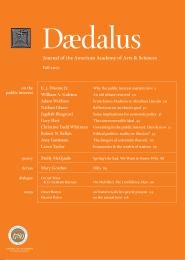Realizing the public interest: reflections on an elusive goal
One would think that having edited for thirty years a journal titled The Public Interest, I should be clear on what the public interest is, how to determine it, and perhaps how to implement it. But after reading hundreds of articles by scholars, journalists, and public figures who have tried, in one area of public policy after another, to define the policies that would truly promote the public interest, I am only left in greater uncertainty as to how to define it.
Nonetheless, the language to express the public interest, as against all the ‘special interests,’ is available. No one has done it better than Walter Lippman, when he wrote: “The public interest may be presumed to be what men would choose if they saw clearly, thought rationally, acted disinterestedly and benevolently.” (Change ‘men’ to ‘men and women’ to account for social changes, and changes in rhetoric, since this statement was published in 1955, and written probably earlier than that.)
Or, in a somewhat more expanded effort by Charles Frankel in 1962: “The ideal of the public interest calls on men, despite their egoism, to set their preferences side by side with the preferences of others, and to examine them all with the same disinterestedness and impartiality. It asks them to seek as tolerable and comprehensive a compromise among those interests as is possible. And it reminds them that every decision they make is a limited one, that some interests may have been overlooked, that something better may be possible.”1
This kind of understanding of the public interest is certainly what Daniel Bell and Irving Kristol had in mind when they founded The Public Interest in 1963. It was a time when there were high prospects for the social sciences as a guide to policy, domestic and possibly even foreign, and when it was hoped that rationality and disinterest would play a larger role in politics and policymaking than ideology, passion, individual power-seeking, and narrow self- and group interest would. These permanent features of the human condition could not be transcended, but at least what would be best, for most of us, could be determined and in any situation of conflict set forth as something for which we should aim. In 1971, John Rawls published a more systematic and rigorous effort to define the public interest, with great influence on political philosophy. A Theory of Justice provoked hundreds, if not thousands, of articles trying to define the public interest. And other earlier systematic efforts, such as Jeremy Bentham’s, were available.
. . .
Endnotes
- 1In the interest of full disclosure, both quotations are in Pendleton Herring’s article on “Public Interest” in The International Encyclopedia of the Social Sciences of 1968.
